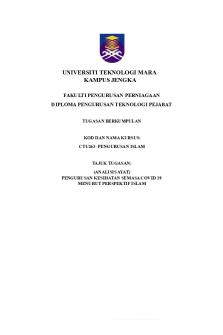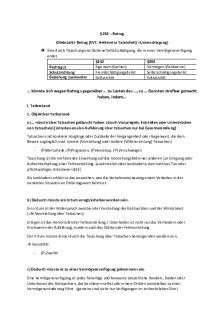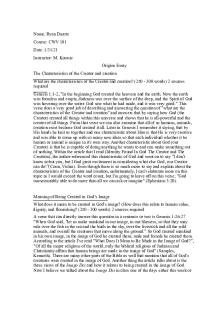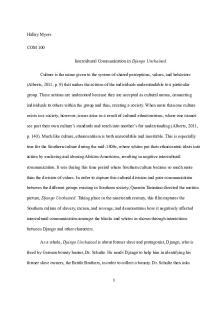Benchmark-Non Christian Symbols essay COM 263 PDF

| Title | Benchmark-Non Christian Symbols essay COM 263 |
|---|---|
| Author | Elizabeth Heicher |
| Course | Elements of Intercultural Communication |
| Institution | Grand Canyon University |
| Pages | 5 |
| File Size | 105.4 KB |
| File Type | |
| Total Downloads | 43 |
| Total Views | 151 |
Summary
Non christian symbols, discovering symbols and rituals that are a part of a culture other than a christian culture. Symbols and rituals are unique to each culture....
Description
1
Benchmark – Non-Christian Symbols
Elizabeth Heicher College of Humanities and Social Sciences, Grand Canyon University COM 263: Elements of Intercultural Communication Instructor Matthews April 18, 2021
2 Benchmark – Non- Christian Symbols In Chinese culture, Buddhism is a common practiced religion. For the Chinese culture and Buddhism, rituals are an important religious practice. Rituals were typically performed on three different occasions. These were for ordination ceremony, the half-month assembly for confession and self-criticism, and rituals performed after a raining retreat (Yu, 2013). Buddhists mainly performed rituals to demonstrate their respect for the Buddha, repent, and to bring about blessings (Yu, 2013). Every ritual in Chinese Buddhism has a purpose and is performed on specific occasions. Symbols also play an important role in what the religion believes is true. The rituals and symbols for Chinese Buddhism has similarities and differences with Christianity, due to how they are conveyed, this is why it is important to have knowledge of the culture, so there are no misunderstandings. Rituals for Chinese Buddhists vary in the degree that they are performed. Penance, offerings, and merit transfers are some of the common Buddhist rituals (Yu, 2013). Chinese Buddhists think it is important to have these rituals to benefit both the living and the dead, as well as oneself and others. Rituals are meant to cleanse one’s soul, so they may live a better life after death. On the other hand, Christianity is very different when it comes to rituals. Christians believe in a rebirth because of all the sins that have been committed in the past. This is why individuals are baptized. Baptism is an important ritual as a person is in a way sworn into the church and made a child of Christ. Holy Communion is another common ritual that is done to cleanse one’s sins and be forgiven. Holy Communion is taken to remember Jesus’ sacrifice, to not only remember his suffering, but also his vast love for us. Lastly, another major ritual is prayer. Prayer is done to thank God for all the blessings he has bestowed, ask for forgiveness, or any other thing that may be concerning the person. Prayer is a time to reflect and take time for
3 oneself. Between the Buddhist rituals and the rituals of Christians, they are very different. Buddhists believe in numerous rituals that are done to help the dead have a better after life, but also a better living life. Their rituals are done in respect for Buddha, whereas Christians do their rituals in respect for God. Christians are different in the sense that their rituals occur due to a debt that can never be repaid. Jesus took all the pain from God’s people so they could live a better life. This can never be repaid, but rituals can help to cleanse one’s sins. There are some similarities between the two groups as both may do rituals in thanks for all the blessing they have received. Another similarity is the way in which both are repentant and ask for forgiveness when any sins are committed. Buddhism and Christianity both have similarities and differences, and this is what makes it important to have some knowledge about both. There are various symbols that are a part of Christianity. For Christians, an important symbol is the cross. The cross represents the sacrifice Jesus made by dying on the cross to bear the sins of the rest of the world. Another symbol is a fish. The fish represents the followers of Christ (Duncklee, 2020). Jesus told those who followed him he would make fishers of men, so this is why the fish serves as a symbol of Christianity. One more of the many symbols is the anchor. The anchor represents safety and was used as an example of the hope Christians have in Christ (Duncklee, 2020) . There is hope in God protecting his people through all the trials and tribulations that one may go through. The anchor has long been a symbol for safety and security in Christ. For Buddhists, there are a series of symbols that represent the teaching of Buddha. One of the most important symbols is the Dharma Wheel. The Dharma Wheel symbolizes the Buddha’s Eightfold Path. There are three swirls in the middle of the wheel that represent the Three Jewels of Buddhism. These are the teacher, the teaching, and the community. The rim of the wheel symbolizes the teachings that are held together through meditation (Fuyu, 2020). This
4 symbol is the key to understanding the Buddhist religion. Another symbol is the endless knot. The endless knot represents the cycle of birth, death, and rebirth (Fuyu, 2020). The knot symbolizes that everything is connected, and nothing can be separated from the rest. One more symbol that represents Buddhism is the lotus flower. The lotus flower represents the purity of the body, speech, and mind (Fuyu, 2020). The lotus flower is very important for Buddhists as it serves as a symbol for rebirth through suffering. When comparing these symbols, the symbol of the cross and the Dharma Wheel are similar in the sense that they represent the main teachings of the religion. However, the other symbols for both Christianity and Buddhism are different. They represent different meanings and are specific for that religion. One of the most important aspects of understanding another culture is being informed. Cultural competence is the key to being able to accurately convey the gospel, aid missionaries in teaching other cultures to obey all that Christ has commanded and avoid theological misunderstandings that may be expressed in that culture’s symbols and rituals. Without proper knowledge of another culture, it can be difficult to thoroughly and accurately convey the gospel. Another culture could be easily offended if the wrong thing is said, and this can create some misunderstandings. According to the textbook, as Christians, the main goal is to communicate who Christ is and to do so in a cross-cultural setting, it is important to be able to effectively communicate interculturally (Moreau, Campbell, & Greener, 2014). Knowing the rituals and symbols of another culture will help to alleviate any potential issues that may arise from having a lack of knowledge and understanding. In the end, it is valuable to have intercultural competence as it makes it possible to effectively communicate with another culture.
5 References Duncklee, E. (2020). Christian Symbols and Their Revelence Today. http://saintsebastianonline.net/download/Ancient-Christian-Symbols.pdf Fuyu. (2020). What are the Buddhist Symbols? https://www.zenlightenment.net/what-are-thesymbols-of-buddhism/ Moreau, A., Campbell, E., & Greener, S. (2014). Effective intercultural communication: A Christian perspective. Baker Publishing. ISBN-13: 9781441245939 https://www.gcumedia.com/digital-resources/baker-academic/2014/effectiveintercultural-communication_a-christian-perspective_1e.php Yu, X. (2013). Re-Creation of Rituals in Humanistic Buddhism: A Case Study of FoGuangShan. Asian Philosophy, 23(4), 350–364. https://doiorg.lopes.idm.oclc.org/10.1080/09552367.2013.831609...
Similar Free PDFs

COM 263 DQ - Discussion
- 8 Pages

benchmark- non christian symbols
- 4 Pages

Topic 6 DQ2 COM-263 - sdfsfd
- 1 Pages

Christian Worldview Essay
- 6 Pages

Symbols
- 1 Pages

Nichtigkeitsklage Art 263 AEUV
- 2 Pages

Tugasan 3 - CTU 263
- 21 Pages

Schema §263 Part1
- 1 Pages

READ Article 263 Notes
- 7 Pages
Popular Institutions
- Tinajero National High School - Annex
- Politeknik Caltex Riau
- Yokohama City University
- SGT University
- University of Al-Qadisiyah
- Divine Word College of Vigan
- Techniek College Rotterdam
- Universidade de Santiago
- Universiti Teknologi MARA Cawangan Johor Kampus Pasir Gudang
- Poltekkes Kemenkes Yogyakarta
- Baguio City National High School
- Colegio san marcos
- preparatoria uno
- Centro de Bachillerato Tecnológico Industrial y de Servicios No. 107
- Dalian Maritime University
- Quang Trung Secondary School
- Colegio Tecnológico en Informática
- Corporación Regional de Educación Superior
- Grupo CEDVA
- Dar Al Uloom University
- Centro de Estudios Preuniversitarios de la Universidad Nacional de Ingeniería
- 上智大学
- Aakash International School, Nuna Majara
- San Felipe Neri Catholic School
- Kang Chiao International School - New Taipei City
- Misamis Occidental National High School
- Institución Educativa Escuela Normal Juan Ladrilleros
- Kolehiyo ng Pantukan
- Batanes State College
- Instituto Continental
- Sekolah Menengah Kejuruan Kesehatan Kaltara (Tarakan)
- Colegio de La Inmaculada Concepcion - Cebu






